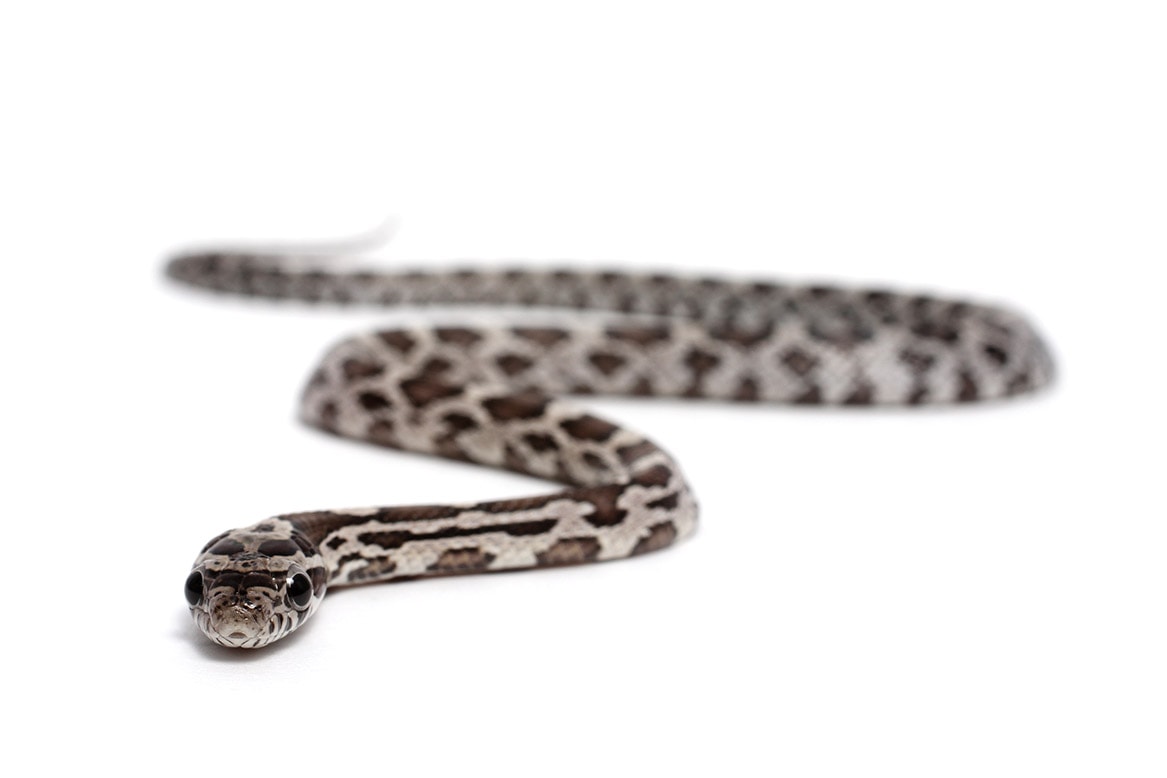

Corn snakes are one of the most popular pet snakes, especially for beginners, because they are docile, accept regular handling, and are generally easy to care for. The Black Corn Snake is a unique morph that makes this docile snake look far more dangerous than it really is! Also known as the Black Devil’s Garden Corn snake, this anerythristic morph is one of the more unique color variations out there and makes for a unique pet indeed.
Read on for more info about this beautiful morph!

Quick Facts About the Black Corn Snake
| Species Name: | Elaphe guttata |
| Common Name: | Black Corn Snake |
| Care Level: | Moderate |
| Lifespan: | 15-20 years |
| Adult Size: | 2.5-5 feet |
| Diet: | Rats and mice or other small mammals |
| Minimum Tank Size: | 20 gallons |
| Temperature & Humidity | Temperature gradient of 75-82°F on the cool side to 80-85°F on the warm side. 40-50% humidity |
Do Black Corn Snakes Make Good Pets?
Corn snakes are one of the most popular and widely available pet snakes for good reasons. They are easy to care for, with generally docile dispositions that make handling them a breeze. Their coloring and patterns are uniquely beautiful — the black corn snake included. They are also the ideal size, big enough to be hardy and regularly handled, but not so big that they’re difficult to look after or intimidating.
Appearance
These snakes are typically not 100% black, but instead, they have a dark grey body with charcoal blotching and patterning that is outlined with black. As juveniles, this coloration is far more contrasting but it evens out as they age. They are a part of the anerythristic type of corn snakes, sometimes known as black albinos, and have an inherited recessive gene that lacks the usual red, yellow, and orange pigmentation.

How to Take Care of a Black Corn Snake
In general, corn snakes are easy to care for but need a warm environment to live in because they do not tolerate cold well. Their setup is still relatively basic, though, and with a suitably sized tank and proper heating, they can live happy, healthy lives.
Habitat, Tank Conditions & Setup
Tank
Corn snakes need a minimum enclosure of around 20 gallons in size (but bigger is always better), preferably glass, with a securely fitted lid because these snakes are expert escape artists. They love to have a place to hide, so you’ll need to provide them with several dark, tight reptile hides and climbing branches. They are also better kept alone because they are not social animals, and a cage mate may cause them undue stress.
We recommend spot-cleaning their tank as often as possible and doing a full clean every 4-5 weeks. You’ll need to remove everything from the tank and clean it with antibacterial soap. Be sure to rinse thoroughly afterward with warm water.
Lighting
There is no special lighting required for corn snakes, but you should try to have their tank near a window where they can adjust to day/night cycles. Avoid direct sun, however, as this can cause their enclosure to swiftly warm to lethal levels.
Heating (Temperature & Humidity)
Your corn snake’s tank will need a temperature gradient that can be provided by a light or heating mat. Around 85 degrees Fahrenheit is perfect for the warmer side, and room temperature is ideal for the cool end. Try to have a long hide that extends through both the hot and cooler side so your snake can choose a comfortable temperature.
Normal house humidity of around 40-50% is fine, and humidity of up to 60% is ideal and will promote healthy shedding. Still, it’s a good idea to monitor your tank’s humidity with a hygrometer to make sure it’s not too dry.
Substrate
Loose substrate is ideal for corn snakes because they love to burrow and hide. This could be various materials, including newspaper and reptile carpeting (AstroTurf) topped with aspen or cypress shavings. Avoid sand or small gravel because it can cause digestive issues and impactions if ingested.
| Tank Recommendations | |
| Tank Type | 20-30-gallon glass vivarium |
| Lighting | N/A |
| Heating | Heating pad/tape on bottom of enclosure or heat lamp with graduated temperatures |
| Best Substrate | Aspen shavings Newspaper Reptile carpeting |

Feeding Your Black Corn Snake
Corn snakes are carnivores and in the wild, hunt and feed in small mammals. In captivity, they can be fed on pinky mice as juveniles and then live mice or rats as they grow to adulthood. Frozen mice that are properly thawed out are also fine, but it may take time to get your snake accustomed to them. Babies should be fed once every 5-7 days and adults once every 7-10 days. Adults will typically eat less around shedding time, so you can reduce their food once they begin the process.
They’ll also need a water dish for hydration; a heavy, shallow dish of around 4 inches in diameter is ideal.
| Diet Summary | |
| Fruits | 0% of diet |
| Insects | 0% of diet |
| Meat | 100% of diet: small/medium-sized rodents, pinky mice for juveniles |
| Supplements Required | N/A |
Keeping Your Black Corn Snake Healthy
Since meeting the housing and diet requirements of a corn snake is relatively easy, keeping them healthy and happy is easy too. The first indication of a healthy corn snake is their eyes; clear eyes are a good indication of a healthy corn snake. They should also be active and moving freely around their habitat, eating regularly, and shedding regularly.
Common Health Issues
Several health issues can affect corn snakes that are not specific to their breed. It can sometimes be difficult to notice illness in corn snakes but for a slight behavior change. Once you get to know the temperament and habits of your corn snake, you’ll be able to tell more easily if something is wrong. Common health issues include:
- Dermatitis
- Respiratory disease
- Stomatitis
- Parasites
Lifespan
In the wild, corn snakes typically live for 6-8 years but have much longer lifespans in captivity. With the right diet and environment, they can easily live for up to 20 years, though on average, they live for around 10-15 years.
Breeding
Corn snakes are generally easy to breed in captivity, and simply keeping a male and female together will likely result in offspring without any encouragement from you. The female will need a comfortable nesting box where she can lay her eggs, ideally with a damp soil mix. The eggs will then need to be incubated for around 60 days at 84 degrees Fahrenheit before they hatch.
While breeding these snakes is relatively easy, incubation and caring for hatchlings is a challenge and best left to experienced breeders.

Are Black Corn Snakes Friendly? Our Handling Advice
While corn snakes are hardy and can be handled regularly, you shouldn’t overdo it. You should begin taming by handling them for short periods only — no more than 5 minutes at a time — and no more than once daily. Once your snake is tame, 10- to 20-minute handling sessions are fine. Do not handle them just after they’ve eaten, as they may regurgitate their food and cause them stress. Do not handle your snake if they are in shed.
Shedding & Brumation: What to Expect
Like all other snakes, corn snakes shed their skin as they grow. Juveniles will shed their skins every 4-6 weeks and adults every 3 months or so. The process usually takes 6-9 days from the beginning to the time that you can handle your snake again.
In the wild, corn snakes will go through a period of brumation in the winter months, and this can be replicated in captivity but is not necessary. If you do place them into brumation, make sure to not feed them but still provide them with fresh drinking water.
How Much Do Black Corn Snakes Cost?
Corn snakes are among the cheapest snake species to purchase from pet stores, averaging around $20-$50. Black corn snakes typically cost a little more, around $50-$60, depending on availability. Even the rarest morphs cost no more than $200 at the highest.
Related Read: How Much Does It Cost to Own a Pet Snake? (Updated in 2021)
Care Guide Summary
Pros
- Docile nature
- Easy to handle
- Simple diet
- Great for beginners
- Easy to care for
Cons
- Must be housed individually

Conclusion
Corn snakes are a great species for beginners, with a wide array of beautiful morphs to explore. Black corn snakes are just one of these unique morphs and certainly one of the most beautiful. With their charcoal and grey coloring and black outlines, they have a wild appearance that is appealing to snake owners. They make wonderful pets overall with low housing needs and a docile and friendly temperament.
Featured Image Credit: Michiel de Wit, Shutterstock
Oliver (Ollie) Jones – A zoologist and freelance writer living in South Australia with his partner Alex, their dog Pepper, and their cat Steve (who declined to be pictured). Ollie, originally from the USA, holds his master’s degree in wildlife biology and moved to Australia to pursue his career and passion but has found a new love for working online and writing about animals of all types.







